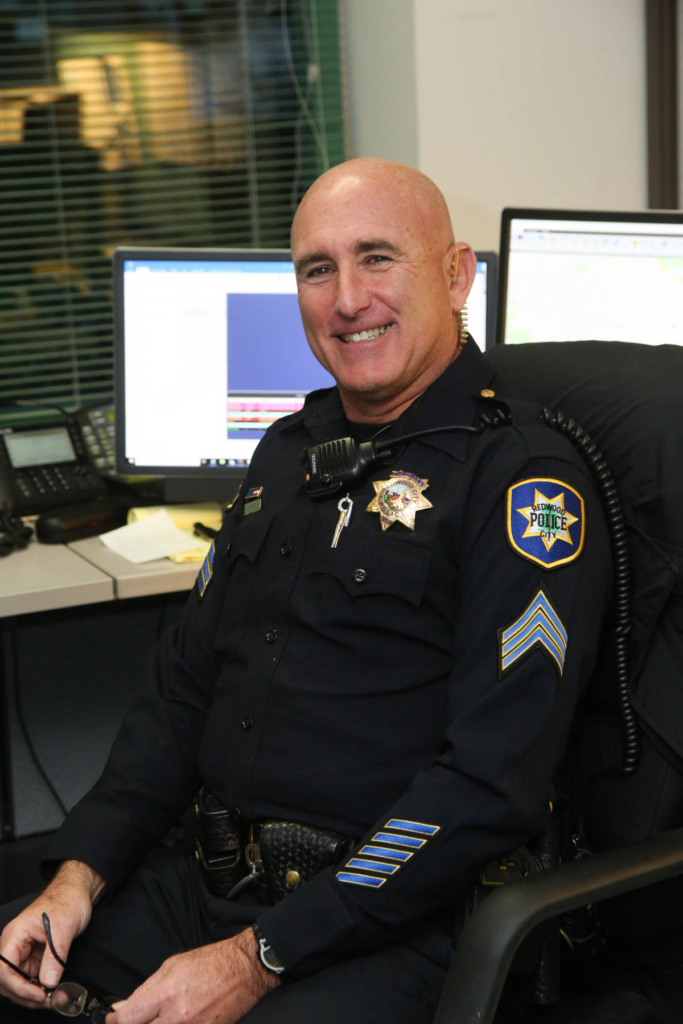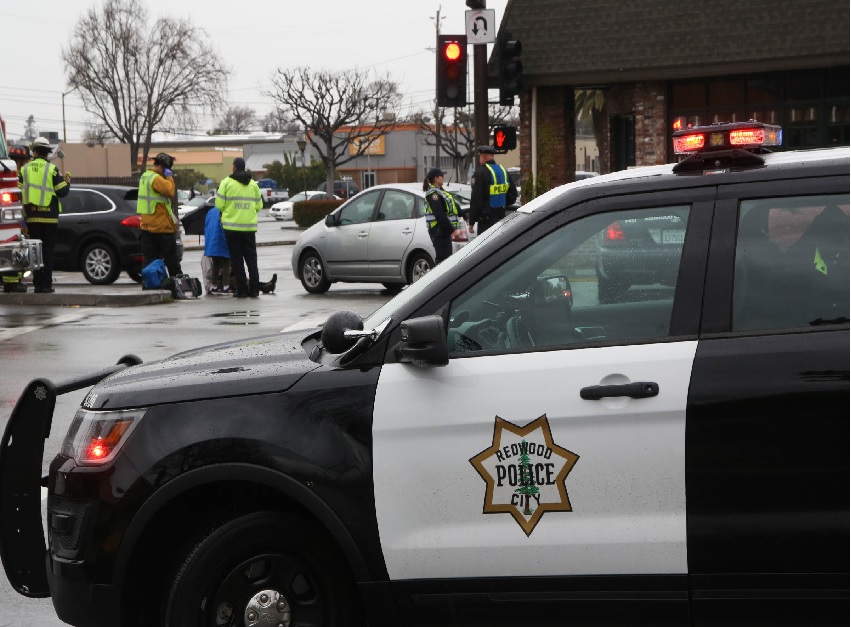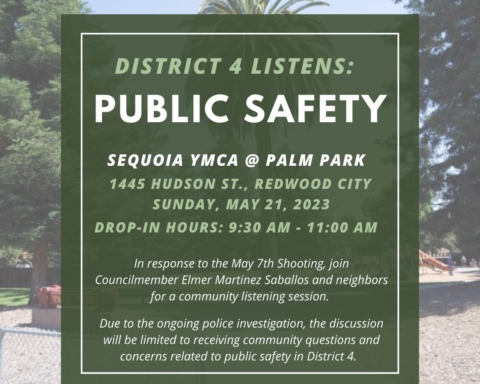The apartment was small and tidy, with a friendly gray dog swooshing her tail and a big-screen TV dominating one wall. On the couch sat an equally neat 29-year-old woman dressed in sweats and wearing her hair in a small bun.
She was quietly sobbing. At 1 p.m., by her own account, she had already consumed a pint of hard liquor. She wanted to try rehab, but then again, somehow, she didn’t.
Two officers, a man and a woman from the Redwood City Police Department, stood near her. The man, Officer Jesse Castro, spoke in the soft tones of a social worker.
“It’s up to you,” he told her. “You’re the one who has to do this.”
“I know,” she said, removing her small horn-rimmed glasses and wiping her eyes. “I know.”
Castro left her in the care of the other officer, Stephanie Aguilar, who was waiting for medical help. The visit, known to police as a “welfare check,” was not the first Castro had made to the apartment. Nor, he suspected, would it be the last.
The call had followed another in which Castro and Officer Daniel Di Bona had been sent to intervene in an argument between two motorists who had met through a fender-bender in a parking lot. Castro had also stopped in to an auto-body shop near the railroad tracks on Chestnut Street. The owner was concerned about a homeless encampment behind his business, next to the tracks.
So it mainly goes these days for the Redwood City police – and they’re not complaining. Thirty years ago, the city was famous to officers around the Bay Area for altercations, gang violence, narcotics and prostitution. If a cop wanted action, Redwood City was a place to find it.

“When I started, it was a rock-and-roll town,” recalls Sergeant Dan Smith, a 25-year veteran of the Redwood City force. “There were rocking bars, and lots of bar fights. We haven’t had a homicide in two years now. We used to have three, four, five a year.”
Smith, a history major at UC-Berkeley who once aspired to teach school, attributes the change to “the evolution of a city.” Much of it, he says, has to do with redevelopment, especially in the downtown core.
“It’s made a big difference,” he says. “Almost all of those bars have shut down. The Fox Theatre became an anchor to the downtown. The 800 block of Main Street used to be a hotspot (for crime). Now we have the Euro Hotel and Angelicas” (as well as a large office-retail complex currently under construction).
The statistics bear out Smith’s on-the-street observations. According to the FBI, which tracks numbers provided by local police departments, serious crime in Redwood City dropped by more than 47 percent between 1995 and 2017. From 2017 to 2018, serious crime dropped by 10.45 percent, according to police-department statistics. (Serious crimes are considered to be homicide, rape, assault, burglary, robbery, larceny and motor-vehicle theft.)
FBI statistics for 2017, the last point for which year-long numbers are available nationwide, show Redwood City is generally safer than California as a whole. The one exception is rape; some 57 rapes were reported to Redwood City police in 2017, compared with a California-wide number of 37.2 per 100,000 population. (City officials estimate Redwood City’s current population at 86,380.) Rapes in Redwood City fell to 46 in 2018.
Mulholland suggests the difference in the California and Redwood City numbers for rape stems from the police department’s efforts to build trust in the community.
“A lot of times people are reluctant to report those crimes,” Mulholland says. “We have to work very hard with those victims in order for them to feel comfortable. I would like to think that there is significant trust-building that’s been taking place within our community over the years – they feel comfortable calling the police and they feel that they are freer to report those to us because of the relationships that we’ve established with them.
“If you have a community that’s comfortable with their police department, that’s more receptive to reporting crimes of a delicate nature … that could tend to contribute to an increase in reporting” Mulholland continues. “There’s always that (possibility) that these crimes could have been taking place all along, but we never knew about them because nobody felt comfortable.”
Smith adds that the type of offense is also important to consider. Rapes, he says, come in three categories – “stranger” rapes, in which someone is attacked by an unknown assailant; date rapes; and status offenses, such as unlawful intercourse between minors.
“I cannot think of the last time we had a stranger rape in Redwood City,” Smith says. “Most parties know each other. ”
Just how safe from crime do citizens feel? Interviews with numerous Redwood City residents reveal that people consider themselves pretty secure.
“I feel very safe,” says Erin Callaghan, co-chair of the Redwood Oaks Neighborhood Association, located in the vicinity of Woodside Road and El Camino Real. “On NextDoor, you see people discussing things, and we used to have someone whom the police were working very diligently to get out of the neighborhood, who was a drug dealer and we kind of knew the ‘drug house.’” (Callaghan says the landlord eventually evicted the suspected dealer.)
“I have big dogs, and I have great neighbors,” Callaghan continues. “We all know each other. We know our schedules, we know our vehicles, we watch out for each other.”
Asked if she feels safe, Redwood City Council member Janet Borgens replies, “Yes, absolutely.” She adds, “I do think the world we live in has changed, and we need to be vigilant.”
Says Borgens, who has lived in town since 1969 and the eastside Friendly Acres neighborhood since the early 1980s, “I don’t leave my doors unlocked, I don’t leave my car unlocked, I don’t leave things on my seat. But I think that’s in any town you’re in, not just Redwood City. But, yes, living in Redwood City, I do feel safe … There was a time when I wouldn’t walk around certain streets alone, but I don’t feel that way anymore.”
Charlotte Russell, a Redwood City insurance agent with offices on Woodside Road, says she, too, feels secure, adding that she has not seen an uptick in her clients’ property-theft claims. Kent Johnson, another insurance agent in town, says he has “not had a claim for property being stolen in the last five years” from his 200 to 300 residential clients.
That’s not to say thefts don’t exist. Last year, the police department logged 1,134 complaints for robbery, burglary and larceny, down from 1,293 the year before. (Robbery includes a threat to a victim, as in a stickup. Burglary includes breaking and entering, and larceny involves other types of thefts.)
A map on the city’s website shows property crimes sprinkled around town, with a concentration downtown and the near west side. (As the bank robber Willie Sutton once famously explained, “That’s where the money is.”) Redwood City’s experience notwithstanding, Castro, the beat cop, says property crimes generally are on the rise and represent local residents’ top public-safety concern.
“They happen everywhere,” he says. “No one is immune. Don’t leave anything visible. Put locks on your side gate. If you put that lock on, then a burglar might pick someone else’s house.
“Don’t advertise,” Castro continues. “A lot of people like to brag on social media about going on vacation. Thieves look at social media, too.”
Second on the list of residents’ concerns, Castro says, is parking – not just downtown, but in the neighborhoods, as well.
“Parking in this city is ridiculous,” Castro says, adding that he typically writes 10 to 20 parking tickets a day. Department-wide, Redwood City police issued around 10,400 parking citations last year, according to Mulholland.
“Parking is huge in my neighborhood,” says Callaghan. “I think in some other neighborhoods that have a lot of apartment buildings, it’s probably worse. But a very good portion of our neighborhood meeting last week was all about parking.”
Callaghan notes that many of her neighbors are so frustrated by the scarcity of parking that they have posted signs advising “No Parking” and “Parking for Residents Only.” The police, she says, are currently developing fliers to advise people that the streets in front of their homes are city property and open to all for parking.
Beyond parking, says Officer Di Bona, residents are highly concerned about homelessness.
From a resident’s standpoint, the homeless often make people feel edgy, threatened or even potentially invaded. Russ Castle, another local insurance agent, speaks with obvious pique about the homeless sleeping behind his business on Woodside Road. “They bring furniture,” Castle says. “You could stay here for a day and get a whole education. Especially on Woodside Road, it’s getting worse every day.”
Callaghan, of the local neighborhood association, acknowledges the presence of homeless people in the area, especially around the interchange of Woodside Road and El Camino Real. For her, however, the homeless represent more than a local issue, although Mulholland suggests the city, as the county seat and center for welfare and mental-health services, may be something of a magnet.
“It’s just like, this is kind of the nature of our world right now, and we need to figure out a solution,” says Callaghan. “We can’t just push it off on somebody else so that it’s no longer our problem.”
For the police, the homeless seem to evoke a combination of compassion and professional concern. Says Di Bona, “They have no place to stay at night, they don’t trust the police, and they’re victims of unreported crimes.”
Whereas the Redwood City police formerly dealt with the homeless through more of an enforcement tack, today the department takes what Mulholland terms a “softer approach.” Each shift has a designated homeless liaison officer, and the police work with other city and county departments and non-profits such as the faith-based Street Life Ministries, which feeds local homeless people and offers additional social services.
The department’s new method stems from an understanding that the homeless are not just an eyesore or the perpetrators of what police call “quality-of-life” crimes such as public urination and drunkenness.
“We can look at someone and recognize, ‘Okay, this is someone that’s in a mental-health crisis, and they need to get plugged into behavior-health services,” Mulholland says. “And perhaps there’s a psychiatric evaluation that needs to be done in order for that person to receive medication to then get them stabilized. And then, (we look for) some sort of warm handoff, where we could then partner with some other entity to try to find some housing somewhere, or placement in a group home.”
“We have officers, including Dan Smith, who I think know every homeless person (in Redwood City) by their first name,” says Borgens, whose husband, Milt, is a retired Redwood City cop. “And that’s a good thing. When you engage with them, find out their stories – you know, how many people look at a homeless person in their face? You walk past them and don’t look at them. And I think if you get to know that element – because that is part of the criminal element on the streets sometimes – they’re trying to survive and they’re doing what they need to survive.”
“We know homelessness is not going away any time soon,” Mulholland says. “And it’s not just a law-enforcement issue. It’s a community issue; it’s a city-wide issue. So how do we all work together to solve this?”
One problem that seems to be coming under control is gang activity. Once notorious for gangs and related violence, Redwood City appears to experiencing far fewer gang-connected issues than before.
Part of the solution, Mulholland and Smith say, has been a joint effort between the Redwood City police and the San Mateo County Sheriff’s office to drive gangs from the area. Mulholland also believes that other, more socially focused programs such as the department’s adopt-a-school program and Police Activities League have enabled officers to connect with youths and attract them away from the perceived glamour of gangs.
Even with the decline in Redwood City gangs, Mulholland says they’re still out there, not just in one location but in all parts of town. Redwood City police continue to participate in a county-wide gang task force among law-enforcement agencies, and work to keep gangs from coming into Redwood City, especially to retaliate for incidents elsewhere.
Less serious than gangs is, nonetheless, something Mulholland says “kind of kills me” – people chattering on social media about crime and suspected criminals in their neighborhoods, without calling the police.
“I’ll hear about somebody saying, ‘Hey, did you see this, or did anybody else have the strange person come by their house after hours, and knock on the door asking to see somebody who doesn’t live there, and they looked really shady?’ Call us. We want you to call us. It’s a good idea to let your neighbors know. But oftentimes we’ll find out that there was never a phone call that was generated to the police department. We’ve almost been robbed of our opportunity to try to get some kind of satisfaction and address those particular issues.”
Calling the police takes trust, and that’s something the department is working hard to build through programs such as citizens’ police academies, “Coffee with the Cops” (an informal outreach at various cafés around town), and its own social-media outlets.
Run by Officer Chris Rasmussen, the department’s social-media program has won numerous awards, and includes a Twitter feed often laced with humor. One recent message celebrated National Doughnut Day, and on Valentine’s Day the department showed a motorcycle officer in wait with a radar gun and the tagline, “Making hearts skip a beat since 1930” (the earliest date Rasmussen could determine the city used police on motorbikes).
Residents who want to follow the department can enter “Redwood City Police” in their Twitter search function, or “@RedwoodCityPD” in their Internet browser. Public-safety information is also available via an online system called “Nixle,” which forwards alerts about weather, traffic, criminal activities, missing persons and local events. To join Nixle, residents can text their zip code to 888777. Nixle messages are available in both English and Spanish.
At the department’s headquarters east of U.S. 101 on Maple Street, the 12-week citizens’ police academies are also offered in both Spanish and English. Mulholland says they fill up quickly with people interested in learning about police work and testing their perceptions of the cops.
One recent participant was Nazia Khanzada, a stay-at-home mom and immigrant from the U.K. with a law degree from the London School of Economics. She says she was concerned about racial profiling and discrimination in enforcement, mainly through viewing social media and news reports.
“I just wanted to see for myself what the Redwood City Police Department was about,” she says. “I found it was much more interesting and detailed than I had perceived.”
As part of her experience, Khanzada rode at night in a police car. Pulling people over, she says, was pretty scary.
“You don’t see people’s faces, because it’s pitch-black. When you’re actually doing that, it’s completely different from how you read stuff online. I actually felt the danger. They can pull over anyone at any time, and you don’t know who’s in the car and how they’re going to behave. For me, that was really eye-opening.”
Khanzada also found domestic disturbances frightening.
“Your emotions are heightened, and you feel stressed,” she says. “You don’t know what kind of situation you’re going into.”
Mulholland hopes first-hand observations such as Khanzada’s will lead people to form an independent view of the Redwood City police.
“They’re looking to the media, whether it’s national news, (or) whether it’s online forums,” Mulholland says. “A lot of times they’re allowing other people to determine what those relationships (with the police) should be, and what their trust levels should be in their police department.”
As local crime falls and the need for social-service policing rises, Mulholland sees changes on the horizon.
“Maybe one might get into police work 30 years ago thinking it’s all about driving fast and issuing tickets and (breaking up) bar fights and solving crimes,” Mulholland says. “And some of that still takes place. But we’ve got a much higher demand for the delivery of social services to folks than we did before.”
Today’s service calls may present different challenges than responding to brawls and car chases, but the outcome can be just as consequential. In December, for example, Redwood City officers answered a call about a man cutting himself with a large kitchen knife, attempting suicide. Tragically, the encounter ended with his being fatally shot. (The district attorney’s office concluded recently that the use of force by the police was legally justifiable and that criminal charges against the officers were not warranted; the family has expressed dissatisfaction with the decision.)
In a city that boasts multi-million-dollar homes and competes daily for high-tech investment, public safety is a paramount concern. Preventing crime, addressing homelessness and steering kids away from gangs all go into that. The community’s law-enforcement priorities may be shifting, but for cops like Smith, Castro, Di Bona and Aguilar, the beat goes on.
This story was published in the April print edition of Climate Magazine.





